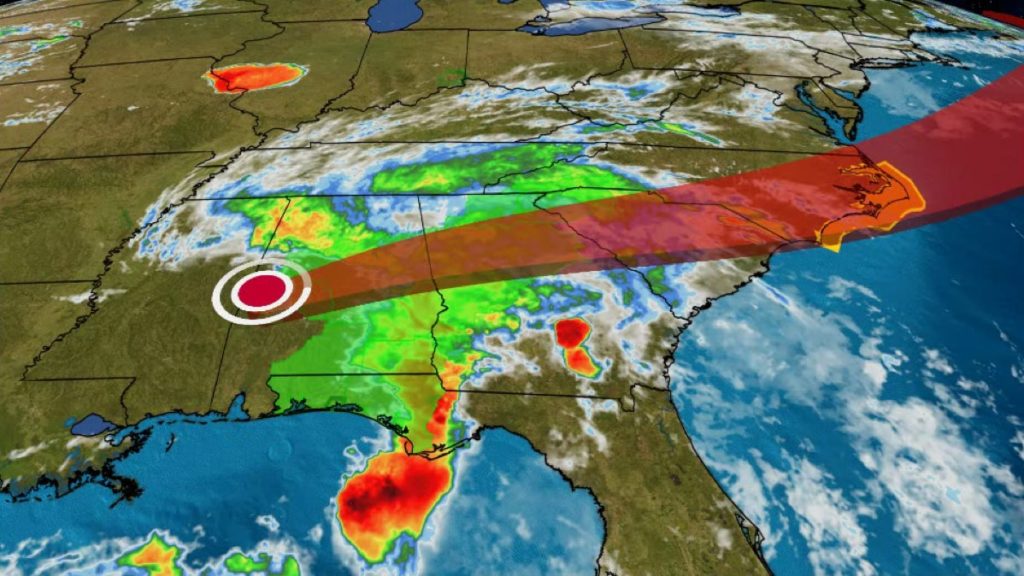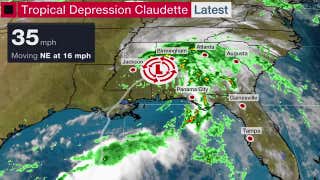
- Claudette formed in southern Louisiana early Saturday.
- This system will bring a threat of heavy rain and flooding to the Deep South into this weekend.
- Storm surge, high surf and rip currents will also be threats at the coast.
Tropical Storm Claudette formed over Louisiana earlier this morning and continues to pose a threat of flooding rain across the Southeast this Father’s Day weekend as a depression. This system could also contribute to coastal flooding, dangerous rip currents and gusty winds.
Tropical storm watches have been issued for a portion of the North Carolina coast from Cape Fear to Duck, including Pamlico and Albemarle Sounds. Winds could reach 40 mph in this area by early Monday.
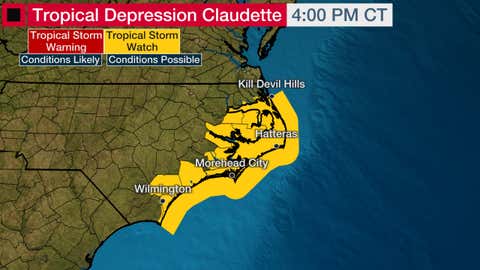
Tropical Storm Watches
(Issued by the National Hurricane Center)
Claudette formed just inland of the Louisiana coastline early Saturday morning. And while it might seem odd that a storm would develop over land, it has happened before.
In 2020, a tropical depression became Tropical Storm Sally over the Florida Everglades.
In 2016, a tropical depression formed as it crossed the Florida coast near Jensen Beach, Florida in east central Florida, then intensified into a tropical storm just inland of Palm Bay, Florida. That storm then rode I-95 northward to near Savannah as a tropical storm before moving offshore.
Forecast Details
Claudette formed early Saturday morning as it was moving through southern Louisiana. Most of its rain and wind are now moving through parts of Alabama, Georgia and the Florida panhandle while its circulation is located in central Alabama.
Claudette should remain a tropical depression as it tracks eastward across the South on Sunday, but will then strengthen early next week over the Carolinas or off the mid-Atlantic coast where it will likely increase the threat of rip currents and gusty winds.

Projected Path and Current Info
(The red-shaded area denotes the potential path of the center of the tropical cyclone. It’s important to note that impacts (particularly heavy rain, high surf, coastal flooding, winds) with any tropical cyclone usually spread beyond its forecast path.)
Shop Top Gifts For Dad at The Home Depot (SPONSORED)
Claudette produced strong winds, heavy rain and storm surge as it moved ashore early Saturday. For a recap on this storm, please read the recap section below.
A few tornadoes have touched down in Florida and Alabama since this morning, including one that caused damage near Castleberry and Brewton, Alabama. That tornado destroyed 50 houses and injured three people.
For the latest impacts across the Gulf Coast, please read this article.
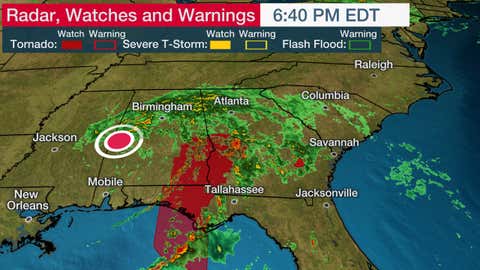
Here are the impacts we expect from this storm:
Forecast Impacts
Rainfall Flood Threat
Heavy rain will spread through parts of the Deep South this weekend.
The heaviest rain is expected from Alabama into the Florida Panhandle, northern and central Georgia and into the western Carolinas. This is where the threat of flash flooding will be highest. Flood watches have been issued in this region.
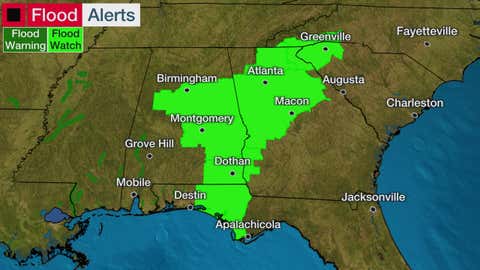
Some locally heavy rain could linger from Georgia into the Carolinas on Sunday, and possibly in the eastern Carolinas and Virginia Monday.
Up to 15 inches of rainfall is possible in portions of the central Gulf Coast. Further inland, from Alabama to the Carolinas, rainfall totals of 3 to 6 inches are likely with up to 8 inches in some areas.

)
Other Threats
Even though wind gusts won’t be overly strong across the Southeast, winds may more easily topple trees due to soaked soil from heavy rain. This may also lead to some scattered power outages near the northern Gulf Coast and into the Deep South.
There could be an isolated tornado threat through Saturday from southern Alabama into southwestern Georgia and the western Florida Panhandle. This threat will shift to the Carolinas and southern Georgia on Sunday.
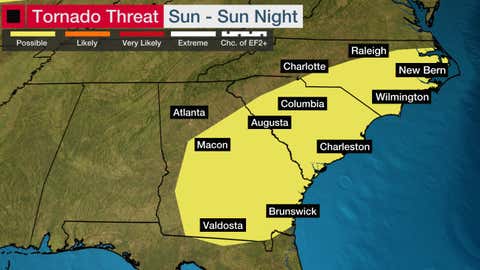
High surf and dangerous rip currents will be concerns in this same general area during that time, and beachgoers are advised to stay out of the ocean.
As the storm comes off the Southeast coast, a storm surge of 1 to 3 feet is also possible in the North Carolina Outer Banks.
Tropical Storm Claudette Recap
Claudette had a lengthy genesis story dating back to the beginning of June.
Initially, a very large spin in the atmosphere over Central America, called a Central American Gyre, produced heavy rain from southern Mexico to Panama. That gyre eventually broke down and produced both Claudette and later Tropical Storm Dolores in the eastern Pacific.
As the storm came north from the Bay of Campeche, it became lopsided to the east due to dry air filtering in from the west and northwest and a surge of winds out of the west aloft, both of which were caused by an upper level low over northern Mexico and Texas. Satellites found winds in excess of 40 mph in the eastern side of the disturbance on June 18th, but the Hurricane Hunters only found a sloppy and very disorganized circulation to the west of most of the thunderstorm activity.
The disturbance that became Claudette became a tropical storm only after crossing the shoreline into Louisiana early on June 19th. West winds along the Gulf Coast confirmed that the system was closed, and the Hurricane Center called the system Claudette at 4 a.m.
Claudette’s worst impacts were seen late on June 18th into early on the 19th as the storm moved ashore as a disorganized low pressure system.
A wind gust of 81 mph was recorded in Pensacola Beach, Florida, where some windows were blown out of at least one hotel and a tractor trailer reportedly blew over on a bridge.
New Orleans recorded a wind gust of 43 mph on Friday evening. Wind gusts of 40-55 mph were reported along the Gulf Coast from Mississippi to Florida. A 46 mph wind gust was also reported near Petit Bois Island, Mississippi and a 50 mph gust was reported near Panama City Beach.
Claudette produced a storm surge of 5.49 feet at Waveland, Mississippi, 4.2 feet at Bayou La Batre Bridge, Alabama and just over four feet at Shell Beach, Louisiana early Saturday morning.
More than 10 inches of rain fell in eastern Louisiana near Slidell.
Here are the storm reports so far:
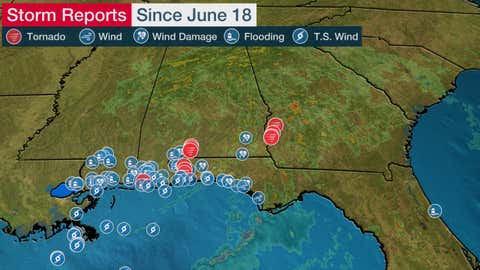
June Gulf Storms
June storms in the Gulf of Mexico are fairly typical.
Since 2000, there have 16 named storms in the Gulf of Mexico. Eleven of those made a U.S. landfall.
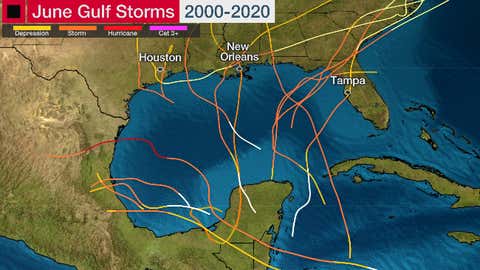
Tracks of all June Gulf of Mexico named storms from 2000 through 2020.
(Data: NOAA/NHC)
The most recent one was last year. Tropical Storm Cristobal formed from the remnant of eastern Pacific Tropical Storm Amanda, then made landfall in southeast Louisiana.
Other June Gulf storms were prolific flood producers, including Debby in 2012 in Florida and Allison’s $9 billion flood in 2001 in Houston.
The last June Gulf hurricane was in 2010.
Hurricane Alex made a Category 2 landfall in northeast Mexico triggered massive flooding in Monterrey, Mexico, where up to 35 inches of rain fell.
June Gulf U.S. hurricane landfalls are extremely rare. The last one was Hurricane Bonnie, 35 years ago.
The Weather Company’s primary journalistic mission is to report on breaking weather news, the environment and the importance of science to our lives. This story does not necessarily represent the position of our parent company, IBM.
